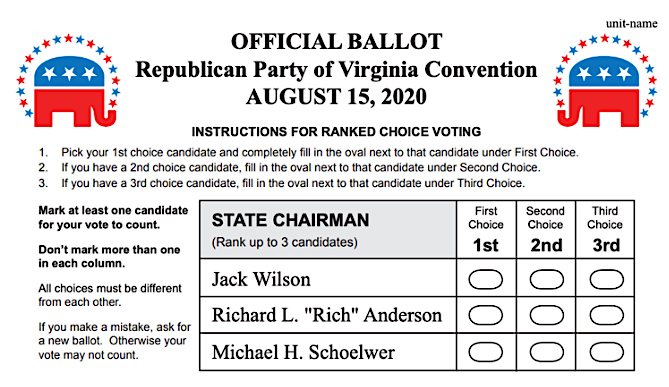
in 2020, the Republican Party of Virginia used the ranked choice voting process to elect a new chair
Source: FairVote, Ranked Choice Voting In Virginia: A Conservative Solution For Party Nominations

in 2020, the Republican Party of Virginia used the ranked choice voting process to elect a new chair
Source: FairVote, Ranked Choice Voting In Virginia: A Conservative Solution For Party Nominations
After the 2020 Census, the Supreme Court of Virginia ended up determining the boundaries of new election districts. That led to a reorganization of an advocacy group which had pushed for minimizing the traditional focus of redistricting, in which the political party in majority redrew the boundaries to maximize partisan advantage for the next decade of elections. OneVirginia2021 relaunched in 2022 as UpVote Virginia, advocating the adoption of ranked-choice (instant runoff) voting to continue "democracy reform" and reduce the pattern of polarized election results.
Ranked choice voting was endorsed as an alternative to plurality voting, where whichever candidate with the most votes is elected, because it ensured that the winning candidate is a person who was supported by a majority of voters. In the ranking process, the winning candidate may have been the second, third, or an even lower preference than the #1 choice of a voter. However, if the top preference(s) of that voter failed to win a majority, then the lower preferences were counted until someone emerged with more that 50% of the vote.
UpVote Virginia anticipated that the process would enhance the success of middle-of-the-road candidates who appealed to both Republicans and Democrats. In primaries with three candidates, ranked choice voting would reduce the potential of an extremist to mobilize a hard-core base of support and win a nomination with as little as 34% of the total vote. In primaries with more than three candidates, the winner could be selected by an even smaller percentage.
Closed primary elections, in which only Republicans may vote for the Republican nominee and only Democrats may vote for the Democratic nominee, spur candidates to campaign on "red meat" issues that galvanize the hard-right or hard-left voters. In districts in Virginia that are reliably Republican or reliably Democratic, winning the primary almost guarantees winning in the general election no matter how divisive a candidate might be.
Ranked choice voting is not the only alternative to selecting a winner by plurality voting. The "top two" primary, also known as the "jungle primary," "blanket primary," and "open primary," can also serve to enhance the potential of moderate candidates. All candidates are listed on the ballot in one primary election. The two candidates who win the most votes are listed on the ballot in the general election. It is possible that the top two candidates will both belong to the same political party, and in the general election supporters of the other political party will be forced to choose between the "lesser of two evils."
California voters adopted the jungle primary in 2010. Republican and Democratic political leaders campaigned against it, since the jungle primary reduced the influence of political parties in choosing candidates. Today it is not uncommon for general election races in heavily-Democratic districts to be between two candidates who are both Democrats, and no Republican is on the ballot. The two Democratic candidates that won in the jungle primary may differ in their policy preferences, but in the general election their political party is only marginally relevant to the voters.
Anther alternative to plurality voting and ranked choice voting for a general election (vs. a primary to nominate candidates) is to hold a run-off election if no candidate wins a majority on election day. In Senate races in Georgia in 2020 and 2022, no candidate won 50% of the vote in the November elections. The top two candidates then competed against each other in run-off elections in December; the other candidates who had been listed on the November ballot were not listed as choices on the December ballot. As a result, Georgia residents were inundated with a second wave of campaign ads. If Georgia had used either plurality or ranked choice voting, no second election would have been necessary.
The attention paid to ranked-choice voting in Virginia was bolstered by successful use of that process in 2020 and 2021.1
The Republican Party used the ranked choice voting process to elect its new party chair in 2020. No candidate won more than 50% of the vote in the equivalent of a first ballot. When the votes of the candidate with the least support were reallocated to the second choice candidate, the new chair was elected with a majority of 62%.2
In 2021, the party used the process to nominate candidates for Governor, Lieutenant Governor, and Attorney General. The Covid-19 pandemic prevented holding the traditional in-person gathering in which thousands of party leaders cast ballots in multiple rounds until a candidate received 50% of the vote.
A primary was an alternative, but there were multiple factions within the party. There was a divisive candidate with a committed base, State Sen. Amanda Chase, who modeled herself after former President Donald Trump. She might win a primary with a small percentage of the overall Republican vote, but if nominated she was unlikely to win a general election.
Virginia had elected Democrats to serve as Governor, Lieutenant Governor, and Attorney General in the last two elections. Both US Senators were Democrats, and since 2008 Virginians had cast a majority of votes for Democratic candidates for president. In 2019 that party had taken control of both the House of Delegates and the State Senate.
Republicans recognized they needed to do something different, and to nominate a candidate perceived as a moderate Republican rather than a Trump acolyte. Choosing to use the ranked choice voting process to select statewide candidates was designed to produce nominees who could unite factions within the Republican Party and also attract independent voters.
Due to Covid-19 restrictions on large public gatherings, Republicans chose to hold an "unassembled convention" in 2021. Voters had to go to one of 39 locations across the state to cast a ballot, in some cases driving 100 miles in order to participate in the election. Logistically, there was no opportunity for casting a second ballot if no candidate won 50% of the total vote, which party rules required. Previous conventions had, on occasion, required delegates to vote multiple times before less-popular candidates withdrew and a candidate finally captured 50% of the votes.
The ranked choice voting process ensured the nominee would have the broadest support. Republicans across the state went to designated local polling sites on May 8, 2021 to cast ballots indicating which of the candidates they preferred. In the race for governor, there were seven candidates. Voters could indicate their #1 choice and also their preferences in sequential order for the six remaining candidates.
Source: Schar School, George Mason University, Ranked Choice Voting (RCV)
The same process was used to select nominees for the 100 seats in the House of Delegates.
All three of the Republican nominees for statewide offices went on to victory in November, 2021. The party also won a majority of seats in the House of Delegates, flipping control from the Democrats.
In the 2022 process for nominating candidates for House of Representatives seats, the Republican Party allowed each district to choose whether to use ranked choice voting. The Seventh District chose to use plurality voting, while the Tenth District used ranked choice voting. After the nomination process was completed, a significantly higher percentage of Tenth District voters thought that the candidates had run a somewhat or mostly positive campaign, compared to Republican voters in the Seventh District (78% vs. 51%).
The 11th District used ranked choice voting, and the Republican Party chair for that district commented:3
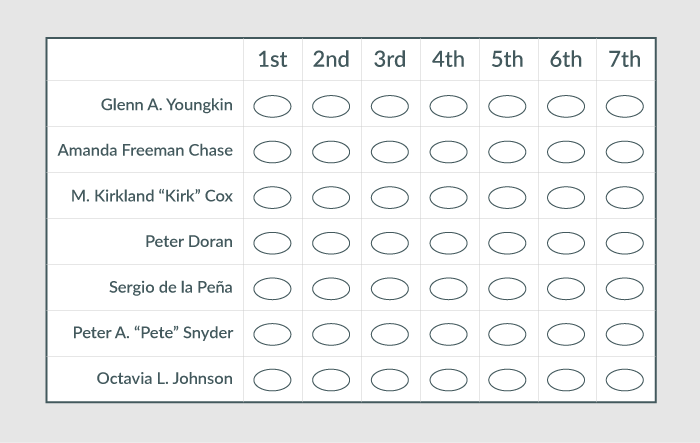
in a 2021 "disassembled convention," Republicans could indicate their preferences for all seven candidates in priority order
Source: Virginia Public Access Project (VPAP), Ranked Choice Voting In Virginia: A Conservative Solution For Party Nominations
The Republican Party also used ranked choice voting in December, 2022 to choose a candidate for the 4th Congressional District seat after Rep. Donald McEachin died. The party highlighted that it had selected an inclusive process, and claimed the firehouse primary used by the Democratic Party was designed to choose the "more extreme candidate pre-selected by Democrat Party bosses." As described in the announcement of the Republican nomination process:4
In 2020, the General Assembly granted local jurisdictions the right to use ranked choice voting for electing local governing bodies, the Board of Supervisors and City/Town Council starting in 2022. The General Assembly was cautious about making changes in the voting process, and the legislation did not allow use of ranked choice voting to elect school boards.
Advocates for ranked choice voting anticipated the City of Richmond would be the first jurisdiction to use the new approach, but in September 2022 City Council rejected it. One objection was that voters would be confused because the only the election for city council would use the ranked choice voting process, since state law did not permit using it for other offices. The standard process, where the person winning the most votes was elected, would still be used for the School Board and for the position of mayor.
Opposition to ranked choice voting in Richmond came primarily from black leaders; they anticipated it might diminish the power of black voters in the city. Richmond's election process had been shaped in the 1970's, after white city leaders had annexed territory from Chesterfield County largely occupied by white residents in a transparent effort to dilute the percentage of the black vote. As specified in the city charter, the person elected as mayor had to win a majority of votes in five of the city's wards. Requiring the mayor to be the winner in a majority of wards empowered the districts with a majority of black voters.5
The first jurisdiction to switch to ranked choice voting ended up being in Northern Virginia. On November 12, 2022, the Arlington County Board of Supervisors voted to adopt the process for the June 20, 2023 primary election. Arlington County had received special authorization earlier in the 2020 legislative session to implement ranked choice voting in 2021. By waiting until 2023, it avoided spending local money to purchase special voting machines.
The Republican Party in Arlington County chose to nominate its 2023 County Board candidates at a mass meeting. As a result, the ranked choice voting process applied to just the Democratic Party nominees chosen in the state-run primary on June 20, 2023.
The Democratic Party in the county had already used ranked choice voting to determine which School Board candidates it would support. The large number of government employees living in the county were relatively informed about election procedures, and were expected to understand the new process.
In 2023, two of the five seats on the Arlington County Board were on the ballot. In the standard plurality voting process for an at-large election, the two candidates receiving the highest number of votes would be elected. Switching to ranked choice voting still resulted in two winning candidates, but guaranteed that they would receive at least 50% of the vote at the end of the process. The alternative way to accomplish that greater-than-50% result would have been to hold a runoff winner-take-all election, requiring voters to come back to the polls a second time.
One member of the County Board said that in years when two seats were on the ballots, she would tell voters that she would be happy to be their second choice. She supported ranked choice voting because:6
The influential Arlington County Civic Federation supported the switch. Republicans rarely won office in Arlington County, so the victory in the Democratic primary was tantamount to election. Ranked choice voting introduced a new way for minority voices to have influence. The past president of the federation said:7
The results of the 2023 Democratic primary for the Arlington County Board, the first publicly run election in Virginia to be decided by ranked-choice voting, were not announced until the Friday evening after the election. The software to determine the winners required only seconds to process the votes, but the deadline for receiving mail-in ballots was noon on Friday.
The main issue was the county's plans to increase "missing middle" affordable housing such as townhouses, duplexes and small apartment buildings. Voters endorsed one supporter and one opponent. If only first-choice votes had been counted, two opponents of the policy would have been chosen.
It took six rounds to determine the two winners. A candidate with 25% of the first-choice votes was one of the eventual winners. Anther opponent received 24% of the first-choice votes, but with six candidates competing for two seats the winning threshold for the first candidate was 33%. For the second candidate, the threshold was 50%.8
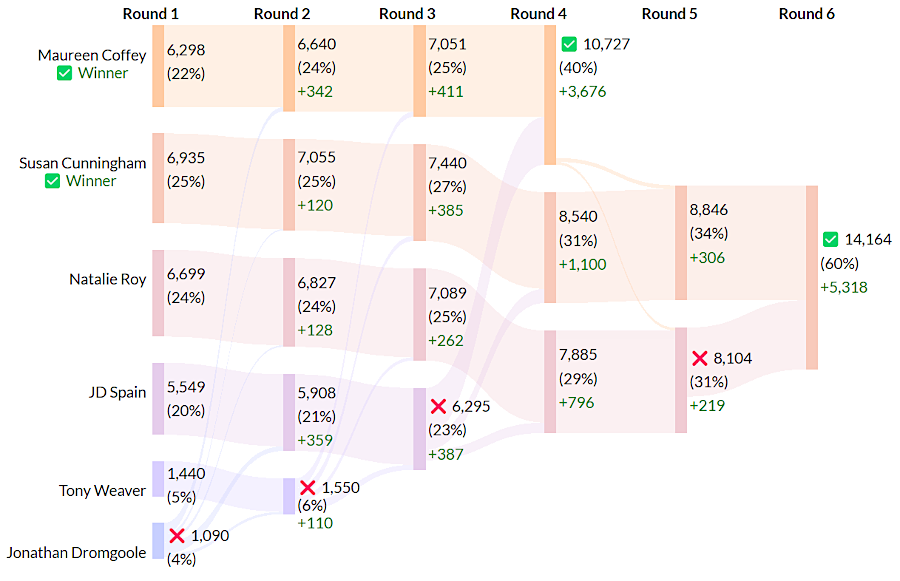
the first publicly run election in Virginia to be decided by ranked-choice voting required six rounds to determine the two winners
Source: Virginia Public Access Project (VPAP), "Ranked Choice" Voting Debuts in Arlington
Arlington County became one of the first local jurisdictions in the United States to adopt ranked choice voting. Pierce County, Washington used it for two elections between 2006-2009. Courts had invalidated the "top two" election process, in which all voters participated in a single primary and the top two vote-getters advanced to the general ballot regardless of political party.
Leaders of the Republican and Democratic parties preferred holding two separate primaries at the same time, and forcing voters to choose between voting in just the Democratic primary or just the Republican primary. After that "pick-a-party" process replaced the "top two" primary, voters in Pierce County rebelled by adopting ranked choice voting.
When a final court decision restored the "top two" primary process, the driving force for using the ranked choice voting disappeared. By switching back to "top two" primaries, the county eliminated the need to print separate ballots.9
Burlington, Vermont used instant runoff voting (IRV) between 2006-2010 to elect the mayor. The candidate chosen in the second election became involved in a corruption scandal. A vote to stop using the ranked choice voting/instant runoff voting process served as a referendum on the mayor, and the city returned to plurality voting. However, voters in 2021 decided that starting in 2023, races for seats on the city council would be decided by ranked choice voting.10
Maine adopted the ranked choice voting process in 2016. In the 2018 race for the Second Congressional District, he Democratic candidate won 45.58% of the vote and the Republican candidate won 46.33%. Two other candidates earned 8.08% of the vote. In a plurality election, the Republican would have won. However, no candidate had won 50% of the vote, so second preferences were considered in a second round of counting. In that round, the second preferences for the two candidates with the least votes were counted, and the Democratic candidate won with 50.62% of the vote.
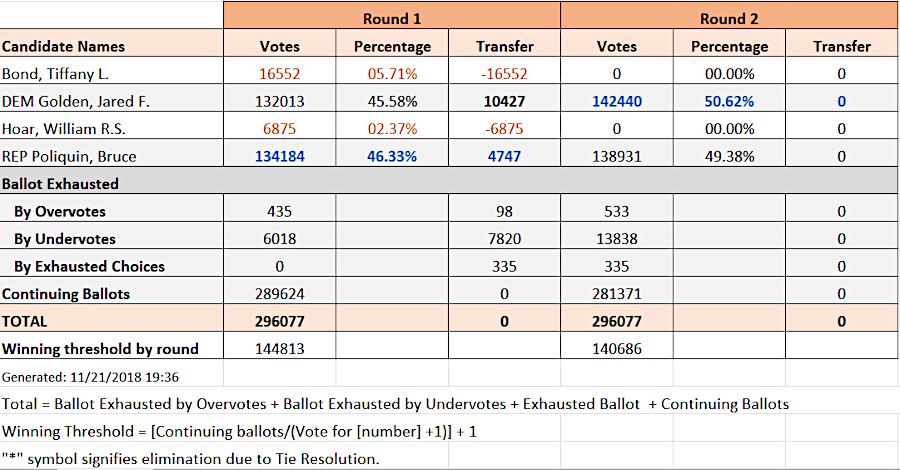
second preferences in ranked choice voting determined the winner in a 2018 Maine election
Source: Maine Department of the Secretary of State, Representative to Congress - District 2 - Results Certified to the Governor 11/26/18
Partisan polarization after the 2016 elections spurred interest, and Alaska voters adopted it in 2020. In a special House of Representatives election in Alaska in 2022 using ranked choice voting, the Republican candidate won more votes than the Democratic candidate but did not capture 50%. When the second choices were counted,
Massachusetts voters rejected ranked choice voting in 2020, but in 2022 Nevada voters approved amending their constitution to allow it. If endorsed a second time in 2024, Nevada would become the third state to adopt the process.11
Voters in New York City approved using ranked choice voting in 2019, and it was first used in the June 2021 primaries. In the Democratic primary for mayor, there were 13 candidates. Voters could indicate their top five preferences on the ballot. About 85% of the ballots were still relevant in the final decision, only 15% of the voters had chosen candidates which were not in the remaining top five and had cast "exhausted" or "inactive" ballots. In the terminology of ranked choice voting, "exhausted" or "inactive" ballots included no preference for the winning and second-place candidates.
Nine municipalities in Salt Lake County, Utah used ranked choice voting in 2021, as did Benton County in Oregon. Hawaii approved it for county council elections in 2023.12
Alington County officials used ranked choice voting for the June 20, 2023 primary but decided not to return to the traditional "first-past-the-post" process in the general election. Voters had nominated two candidates without voting twice, and the outdated voting machines had allowed voters to rank just three candidates when six were on the ballot.
The candidate with the second-highest number of votes would have won the second seat, had Arlington used the "first-past-the-post" process. She was aligned with the candidate who had the highest number of votes. Because the candidate who received the highest number of votes was never eliminated, under the ranked choice voting process the second choice of her voters was never counted. Had the ranked choice voting process been designed so those second choice votes had been counted, the decision on the second vacancy might been different.
After the November 2023 General Election, the Arlington County Board decided to use ranked choice voting for all future primaries for County Board seats. It did not commit to using the process for general elections.13
The board did chose to use ranked choice voting for the 2024 general election, if there would be three or more candidates on the ballot. It would be another opportunity to test the capacity of the elections staff to use the process, and to gauge public response to it. The Chair of the Arlington County Board said:14
In 2024 the General Assembly passed legislation authorizing local jurisdictions to adopt ranked choice voting for all local elections. That would have expanded the option beyond just city council and board of supervisor elections, but Governor Glenn Youngkin vetoed the bill. Youngkin had won the Republican nomination for Governor in 2021 in a party-run convention that used ranked choice voting.
On September 3, 2024, Charlottesville's City Council adopted ranked choice voting for city council elections starting with the June 2025 primary. City Council also approved funding for an education and outreach program, so voters would be prepared for the new process.
Members recognized the significance of initiating ranked choice voting. If it became routine and well understood, they expected the General Assembly to authorize it for more than just local elections. One said:15
There ended up being three candidates for two seats. To win, two candidates needed to earn at least 1/3 of the votes. As described in the city's 2025 voter guide:16
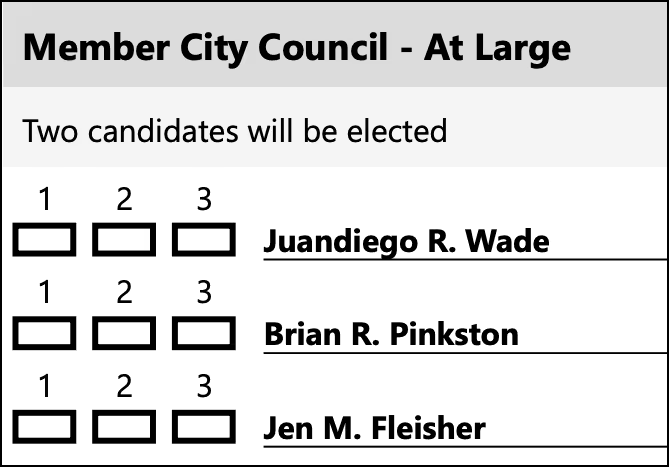
Charlottesville became the second Virginia jurisdiction to use ranked choice voting, when three candidates ran for two City Council seats in 2025
Source: City of Charlottesville, How to Vote in a Ranked Choice Election
In 2024, Washington DC voters approved using ranked choice voting in future elections. Nationwide, however, voters rejected proposals to adopt the method in Colorado, Nevada, Oregon and Idaho. Alaska voters were almost evenly split on a ballot issue to ban the process. Opponents emphasized the process was confusing, and also that it would benefit wealthy individuals who could afford to fund their campaign and increase name recognition.17
The 2025 General Assembly passed SB1009, establishing technical requirements as requested by Governor Youngkin for the State Board of Elections to oversee elections using ranked choice voting. The state agency would have to determine that use of ranked choice voting was feasible before a jurisdiction could use the process, and was empowered to adopt new recount procedures for ranked choice voting elections.
The governor still vetoed the bill, saying:18
By the time US Representative Gerry Connolly died in May, 2025, the Fairfax County Democratic Committee had adopted ranked choice voting as its standard process for choosing candidates in a firehouse primary.19
On June 17, voters chose Ghazala Hashmi as the Democratic Party nominee for Lieutenant Governor. In the six candidate primary, she won 27.39% of the vote. That was the lowest winning percentage ever in a statewide race in Virginia, below the 32.9% received by Leslie Byrne for Lieutenant Governor in a four-person race in 2005.
The second place candidate in 2025 won 26.65% and the third-place candidate won 26.16% of the total vote. Had ranked choice voting been used, the ultimate winner would have received over 50% of the vote.20
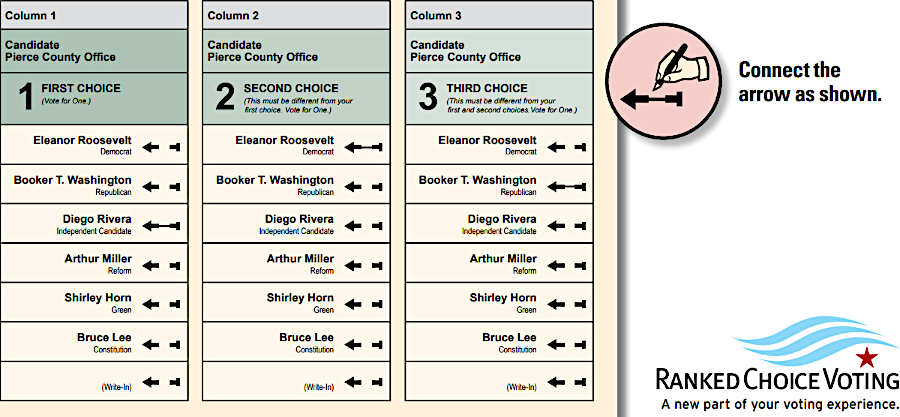
Pierce County, Washington was the first jurisdiction to use ranked choice voting for local elections
Source: Pierce County, Washington, Informational Brochure
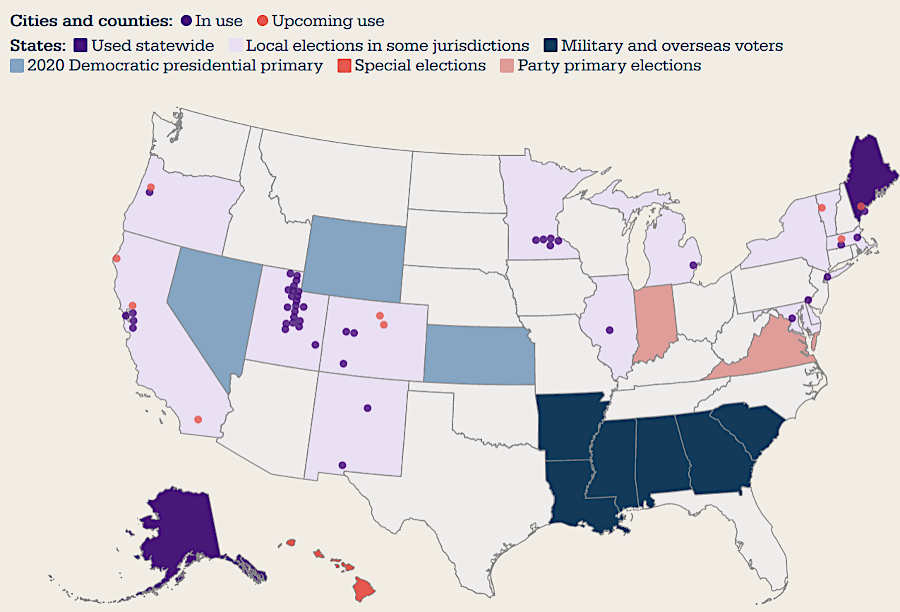
by July 2022, various jurisdictions had authorized various forms of ranked choice voting
Source: FairVote, Ranked Choice Voting